RBSE Solutions for Class 6 Maths Chapter 3 Playing With Numbers Ex 3.5
Rajasthan Board RBSE Solutions for Class 6 Maths Chapter 3 Playing With Numbers Ex 3.5 Textbook Exercise Questions and Answers.
RBSE Class 6 Maths Solutions Chapter 3 Playing With Numbers Ex 3.5
Question 1.
Which of the following statements are true?
(a) If a number is divisible by 3, it must be divisible by 9.
Answer:
False : 6 is divisible by 3 but not by 9.
(b) If a number is divisible by 9, it must . be divisible by 3.
Answer:
True : As 9 =. 3 x 3. Therefore, if a number is divisible by 9, then it will also be divisible by 3.
(c) A number is divisible by 18, if it is divisible by both 3 and 6.
Answer:
False : 30 is divisible by 3 and 6 both but it is not divisible by 18.
(d) If a number is divisible by 9 and 10 both, then it must be divisible by 90.
Answer:
True : As 9 × 10 = 90. Therefore, if a number is divisible by 9 and 10 both, then it will also be divisible 90.
(e) If two numbers are co-primes, at least one of them must be prime.
Answer:
False: 15 and 32 are co-primes and also composite.
(f) All numbers which are divisible by 4 must also be divisible by 8.
Answer:
False: 12 is divisible by 4, but not by 8.
(g) All numbers which are divisible by 8 must also be divisible by 4.
Answer:
True : As 8 = 2 × 4. Therefore, if a number is divisible by 8, then it will also be divisible by 2 and 4.
(h) If a number exactly divides two numbers separately, it must exactly divide their sum.
Answer:
True : 2 divides 4 and 8 as well as 12 (4 + 8 = 12).
(i) If a number exactly divides the sum of two numbers, it must exactly divide the two numbers separately.
Answer:
False: 2 divides 12 but does not divide 7 and 5.

Question 2.
Here are two different factor trees for 60. Write the missing numbers.
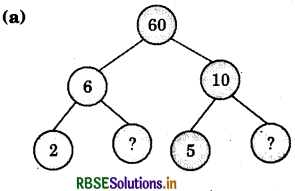
Answer:
As 6 = 2 × 3 and 10 = 5 × 2
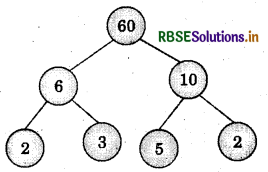
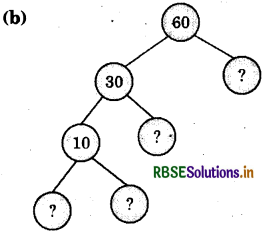
Answer:
As 60 = 30 × 2, 30 = 10 × 3 and 10 = 5 × 2
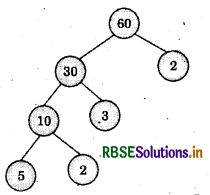
Question 3.
Which factors are not included in the prime factorisation of a composite number?
Answer:
1 and the number itself are the factors which are not included in two prime factorisation of a composite number.
Question 4.
Write the greatest 4-digit number and express it in terms of its prime factors.
Answer:
The greatest 4-digits number = 9999
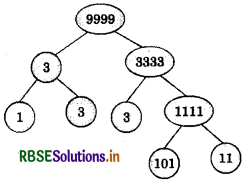
The prime factors of 9999 are 3 × 3 × 11 × 101.
Question 5.
Write the smallest 5-digit number and express it in the form of its prime factors.
Answer:
The smallest five digit number = 10000.
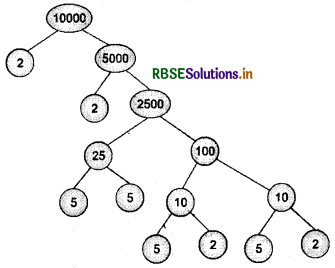
The prime factors of 10000 are 2 × 2 × 2 × 2 × 5 × 5 × 5 × 5.

Question 6.
Find all the prime factors of 1729 and arrange them in ascending order. Now state the relation, if any, between two consecutive prime factors.
Answer:
Prime factors of 1729 in ascending order are 7 × 13 × 19.
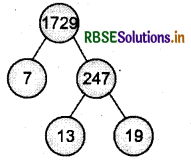
The difference of two consecutive prime factors is 6.
Question 7.
The product of three consecutive numbers is always divisible by 6. Verify this statement with the help of some examples.
Answer:
Among the three consecutive numbers, there must be one even number, and one multiple of 3. Thus, the product must be multiple of 6.
Example :
(i) 2 × 3 × 4 = 24
(ii) 4 × 5 × 6 = 120
Question 8.
The sum of two consecutive odd numbers is always divisible by 4. Verify this statement with the help of some examples.
Answer:
3 + 5 = 8 and 8 is divisible by 4.
5 + 7 = 12 and 12 is divisible by 4.
7 + 9 = 16 and 16 is divisible by 4.
9 + 11 = 20 and 20 is divisible by 4.
Question 9.
In which of the following expressions, prime factorisation has been done?
(a) 24 = 2 × 3 × 4
(b)56 = 7 × 2 × 2 × 2
(c) 70 = 2 × 5 × 7
(d) 54 = 2 × 3 × 9
Answer:
In expressions (b) and (c), prime factorisation has been done.

Question 10.
Determine if 25110 is divisible by 45.
(Hint: 5 and 9 are co-prime numbers. Test the divisibility of the number by 5 and 9.)
Answer:
The prime factorisation of 45 = 5 × 9
25110 is divisible by 5 as 0 is at its units place.
25110 is divisible by 9 as sum of digits is divisible by 9.
Therefore, the number must be divisible by 5 × 9 = 45.
Question 11.
18 is divisible by both 2 and 3. It is also divisible by 2 × 3 = 6. Similarly, a number is divisible by both 4 and 6. Can we say that the number must also be divisible by 4 × 6 = 24? If not, give an example to justify your answer.
Answer:
No, number 12 is divisible by both 6 and 4 but 12 is not divisible by 24.
Question 12.
1 am the smallest number, having four different prime factors. Can you find me?
Answer:
The smallest four prime numbers are 2, 3, 5 and 7.
Hence, the required number is 2 × 3 × 5 × 7 = 210.
